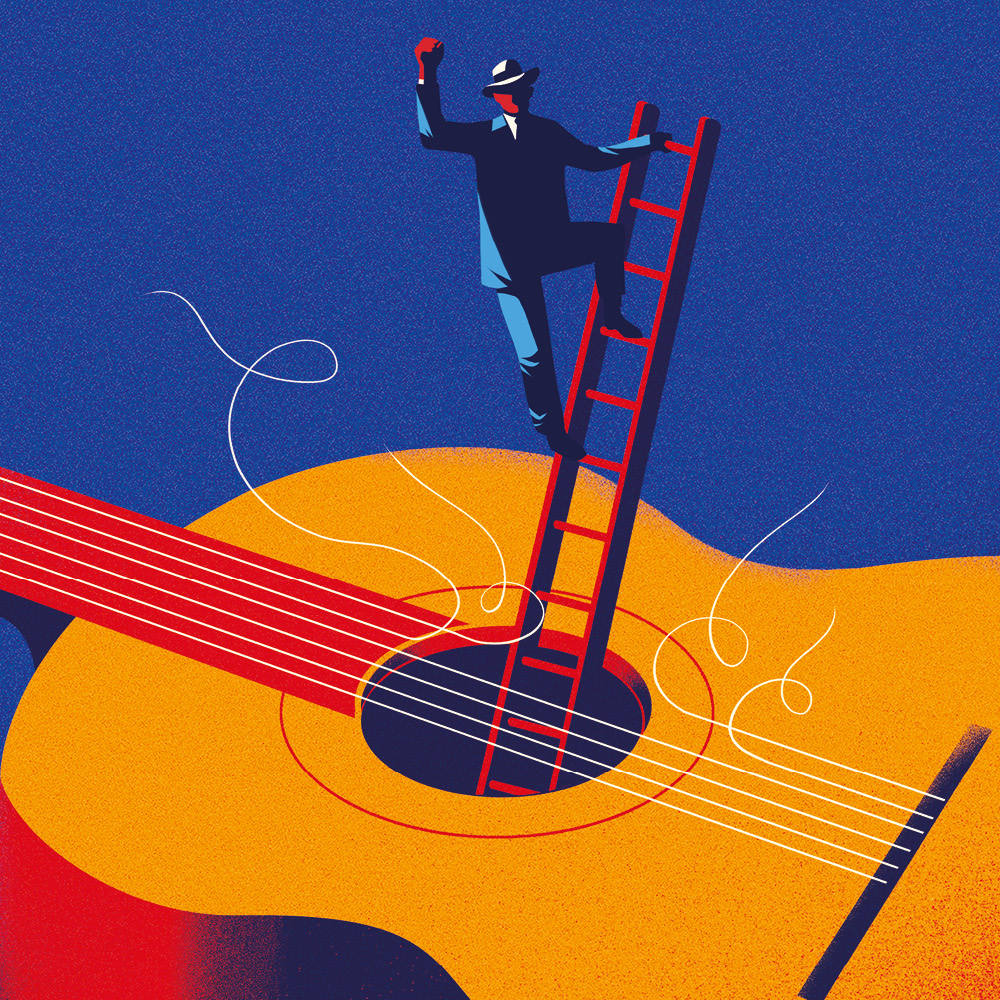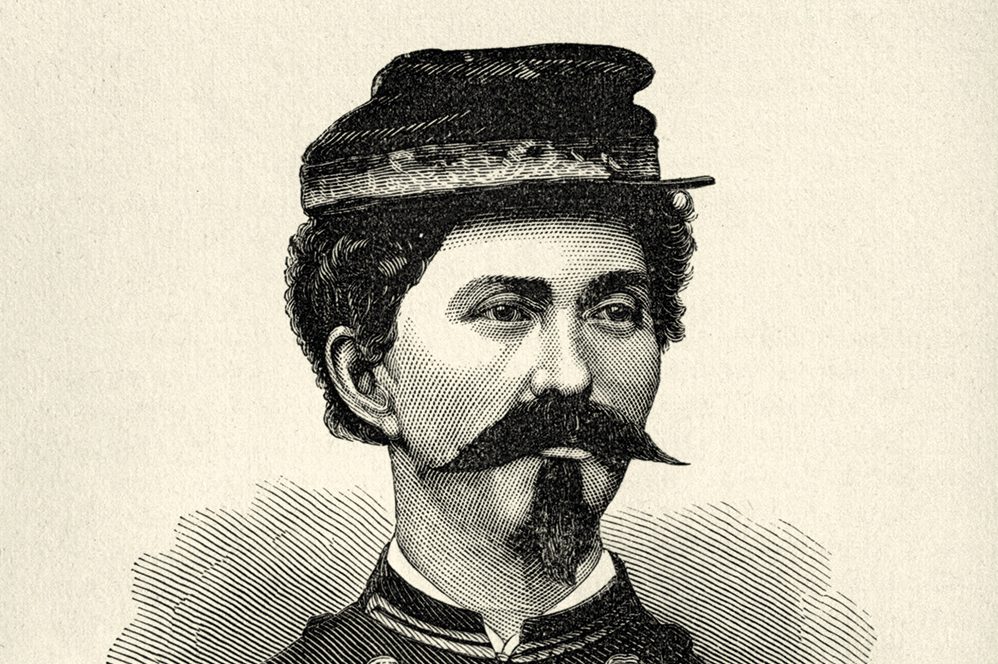A noise booms from a downtown district of Kyiv. It’s not the screech of a piercing siren or a building collapsing into rubble but the pumping beat of electronica. Throughout the deafening clamor of the Russia-Ukraine war, Gasoline Radio has kept broadcasting, mixing contemporary electronic music with traditional folk to fortify Ukrainian national identity.
Whether pumped out by electronica DJs, violinists playing for families in shelters or singers performing in the shelled-out carcasses of cities, all is far from quiet on the cultural front of Ukraine. Wherever there is oppression, there is resistance, and music has long been a weapon for these war-weary civilians.
These stories of resilience — from interviews with players in Ukraine’s philharmonic orchestras to those mixing music on community radio — bracket Rebel Sounds: Music as Resistance, the latest eye- and ear-opening book from Joe Mulhall. Rebel Sounds is an uplifting compendium of hidden histories of those who have produced, performed and distributed music in times of war, despite the dangers that they have faced.
Music’s aesthetic power is well-known and documented, but less is written about how it has been a means of resistance, defiance and subversion. There is Dorian Lynskey’s superbly meaty 33 Revolutions per Minute: A History of Protest Songs, but the topic still warrants greater exploration, as there has never been a definitive book about the role that resistance music has played in people’s lives.
It’s good timing. The past year has served as a clarion call to identify oppression and resist it worldwide, from the pro-Palestine protests on American campuses to the dehumanizing laws that silence women in Afghanistan and Iran. How has music contributed to resisting oppression in history, and what insights can it offer for now?
As a journalist, music-obsessive and director of research for the UK’s equivalent of Media Matters and habitual canceler of right-wingers, HOPE Not Hate (HNH), Mulhall is precisely placed to find out. Like a troubadour keen to rid the world of its troubles through song, Mulhall looks to the past and reports from the present to discover whether music can “change the world,” and he does so with empathy and enthusiasm.
The seeds of Rebel Sounds were sown when Mulhall stumbled upon an exhibition of the same name in London’s Imperial War Museum, which highlighted everything from the rise of jazz in Thirties Nazi Germany to the blues scene in present-day Mali. Despite sharing the same title and a similar melody, Rebel Sounds is Mulhall’s own composition — and what a lively one it is.
He ventures to Ireland, North America, Nigeria, Poland, Ukraine and South Africa to look for answers, dividing the chapters by country, and there’s a lot of ground to cover. At times, you are left wondering if perhaps the author has been overambitious, but a 269-page-long book can only offer an amuse-bouche to the most critical of fault-finding historians and melomaniacs.
Mulhall is refreshingly candid about the book’s pitfalls, apologizing for the inevitably truncated histories of various regimes and systems of oppression. If you are after a scholarly take on the Irish Troubles, the rise and fall of the Soviet Union or the impact of the Chilean charango, this is not the book for you.
Instead, Rebel Sounds is an accessible snapshot of music as a soundtrack to life. Like Anthony Bourdain in Parts Unknown, Mulhall is intriguing, informative and impassioned in his on-the-ground storytelling, interviews and encounters. And, channeling Bourdain, he adds dry and self-deprecating humor when appropriate, from his being made to sing by a famous Irish civil rights leader to dancing through a crippling hangover at a hip-hop museum in New York. There is much-needed light relief between grisly stories of oppression and violence.
Mulhall introduces us to fascinating characters — dead and living — along the way, like the late Beatles fanatic Kolya Vasin, who, despite Soviet Union bans and censorship, festooned his walls with Beatles bootleg and memorabilia, even creating the John Lennon Temple of Peace and Love in Leningrad. And Modise Phekonyane, a former prisoner on Robben Island in South Africa who was arrested for taking part in anti-apartheid student protests and detained without trial. Phekonyane now gives tours on the island and in a particularly emotional anecdote, tells Mulhall of his time in prison and how musical instruments given by the Red Cross became his salvation.
The recommended listening at the overture of each chapter is also a lovely touch. While not wholly original — Joe Boyd’s recently released And the Roots of Rhythm Remain: A Journey Through Global Music has done something similar with a Spotify accompaniment — Mulhall’s suggestions are thoughtfully chosen and curated rather than mashed into a shapeless playlist.
You could, if you wished, listen to Billie Holiday’s lynching anthem “Strange Fruit” while learning how the song politicized black consciousness, or to the Specials’ “Ghost Town” as you discover the story of 2 Tone Records — the multiracial label that heralded new ideas of race and culture in Britain. Alternatively, the listening suggestions may have been better placed as outros so the reader can hear how the stories were manifested into song.
Mulhall’s eclectic enthusiasm packs the pages of Rebel Sounds with childlike wonder, whether he roams the streets of New Orleans (“I had seen sites I have dreamt of my whole adult life. I had drunk in bars once graced by B.B King and stood on the spot where Aretha Franklin recorded ‘I Never Loved a Man (The Way I Love You)’”) or waxes lyrical about the influence of genres like soul (“It can be a heartbreak set to lush strings or jubilation in a hip thrust. It can feel like being doused in molasses or being woken up with a pail of water to the face. Soul music reaches inside you and twists”). Several of his reflections teeter on the verbose, but Mulhall’s steadfast belief in music as a powerful form of resistance and empowerment cannot be denied.
While classical music may not have been as prominent as soul or funk in soundtracking the civil rights struggle in America, it would have been a welcome addition to hear about twentieth-century trailblazers such as William Grant Still, the first African American to conduct a major orchestra, or Marian Anderson, the first African-American singer to perform at the Metropolitan Opera. Moreover, the chapter on classical music feels incomplete in its choice to focus mainly on the 1950s and 1960s civil rights struggle. Mulhall talks briefly of the emergence of the Black Power movement in the late Sixties, and hip-hop forefathers the Last Poets, but there is nothing on how the Black Panther Party used music as a tool of resistance and mobilization through their group the Lumpen. It is a shame Mulhall’s trip had to end with the birth of hip-hop just as things were heating up.
Mulhall is wise to devote a chapter not just to Nigeria but to focus on the life and legacy of Fela Kuti, the father of Afrobeat. He explores how Kuti etched resistance into the heart of Afrobeat — in protest anthems such as “Zombie” and “Coffin for Head of State” — to promote African unity and draw attention to the country’s endemic corruption and violence. In referencing how contemporary musicians like Kuti’s son Femi and the inventive British band Ezra Collective have been inspired by his work, the chapter firmly roots itself in the past and the present. It is a shame that Mulhall did not explore similar synchronicity in other chapters, which would have given this book an authority and urgency it occasionally lacks.
Rebel Sounds is Mulhall’s third book, and it is by far his most personal. This is particularly clear in the chapter “White Riot: Rock Against Racism (RAR) and 2 Tone Records in Britain,” where he offers accounts of how his grandfather’s mixed-race marriage made way for a “very modern British love story” against a backdrop of racial prejudice, and the way in which Red Saunders, co-founder of RAR, fused pop and politics to make a blueprint for a multicultural Britain. David Bowie, Eric Clapton and Rod Stewart fans should proceed with caution in this chapter, as some revelatory — and jaw-dropping — quotes about their idols’ ill-informed admiration or support for Enoch Powell and Hitler await.
Mulhall also secures an interview with protest music’s biggest headliner, Billy Bragg, whom he clearly admires. When Mulhall asks him if music can change the world, Bragg is cautiously optimistic. “The role that music has to play is not to change the world,” says Bragg, “but to make you believe the world can be changed.”
Rebel Sounds serves as a potent reminder of how music can epitomize the soul of a movement and be a rallying cry, a way to unify and a reason to persevere. Rebel music doesn’t need to be political, Mulhall concludes; not everyone needs to storm the barricades with a saxophone in one arm and an AK-47 in another. Sometimes, the very act of listening is enough to inspire change. And sometimes, the very act of reading these tales of resistance is enough to inspire change too. Music may not stop the tanks from rolling or missiles from being fired, but its power in harmonizing hope should not be underestimated.
This article was originally published in The Spectator’s November 2024 World edition.























Leave a Reply